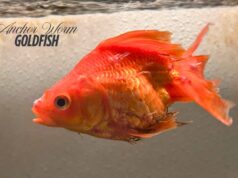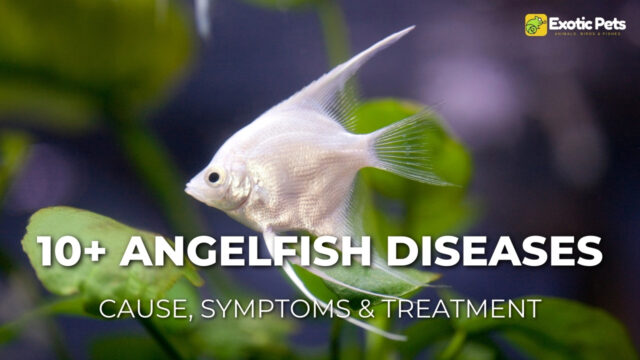
Angelfish are among the most popular choices for freshwater aquariums due to their beautiful appearance and fascinating behaviors. However, like any aquatic pet, they are susceptible to various diseases. Knowledge of these illnesses, their symptoms, and potential treatments is crucial for maintaining a healthy tank environment. This blog post will delve into the 13 most common angelfish diseases and illnesses, providing insights into their causes, symptoms, and treatment options.
Early Warning Signs of Illness in Angelfish
Before we dive into specific diseases, let’s look at some general signs of illness in angelfish:
- Lethargy: Reduced activity or lack of interest in food.
- Loss of Appetite: Refusal to eat or decreased interest in food.
- Clamped Fins: Fins held close to the body.
- Labored Breathing: Rapid or gasping breaths.
- White Spots: Small white spots on the body or fins.
- Redness or Inflammation: Noticeable redness or swelling.
- Bloating: Abnormal swelling of the abdomen.
If you notice any of these signs, it’s important to act quickly. Early intervention is often key to successful treatment.
Common Angelfish Diseases
Here’s an overview of common freshwater angelfish diseases:
- Dropsy
- Ich (Ick)
- Fin Rot
- Velvet Disease
- Angelfish Hexamita
- Gill Flukes
- Anchor Worms
- Swollen Belly
- Mouth Fungus
- Popeye
- Cotton Wool Disease
- Swim Bladder Disorder
- Virus Infections
1. Dropsy in Angelfish
Dropsy in angelfish is primarily caused by a bacterial infection that occurs when the fish’s immune system is compromised. Poor water quality and stress are common factors that weaken the immune defenses, allowing bacteria to invade and affect the kidneys, which then leads to fluid accumulation in the body.
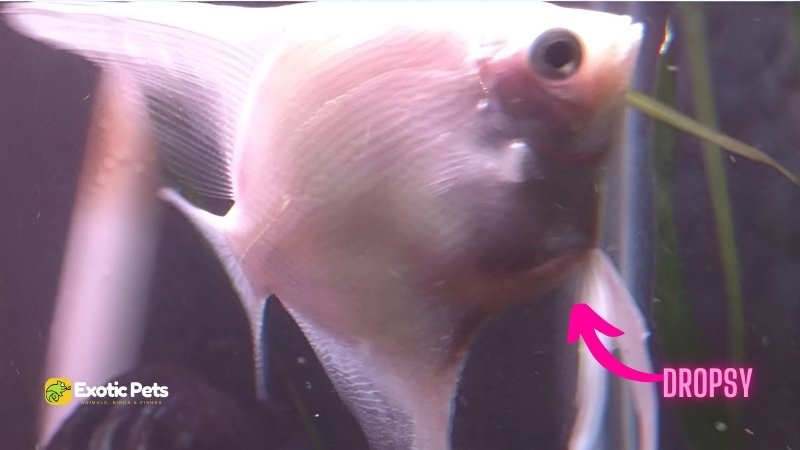
Cause: Bacterial infection causing fluid accumulation, often secondary to organ damage.
Symptoms: Severe bloating, scales sticking out (pineconing), lethargy.
Treatment: Difficult to treat, but antibiotics may be attempted. Prevention is key through good water quality and a healthy diet.
Symptoms of Dropsy in Angelfish
- Scales stand out from the body, giving a pinecone-like appearance.
- Swollen, bloated belly.
- Bulging eyes.
- Lethargy and loss of appetite.
Angelfish Dropsy Treatment
Dropsy can be fatal if not diagnosed and treated early. The following steps should be taken:
- Consult a veterinarian specialized in fish diseases as soon as symptoms are noticed.
- Isolate the affected fish to prevent the spread of the infection.
- Add ⅛ teaspoon of Epsom salt per 5 gallons of water to help flush out the bacteria.
- Incorporate antibacterial medications into the food.
- Slightly increase the water temperature to support the immune system.
- Improve tank conditions by ensuring clean and well-maintained water, reducing stressors.
- Feed antibacterial foods, such as those containing garlic, to support recovery.
Prompt and effective treatment, along with maintaining excellent water quality and minimizing stress factors, are key to managing Dropsy in angelfish.
2. Angelfish Ich (Ick)
Ich, or White Spot disease in Angelfish, is caused by the protozoan parasite Ichthyophthirius multifiliis. While all fish may carry this parasite latently, outbreaks are often triggered by stress factors such as sudden changes in water temperature, the introduction of new fish or plants from an infected tank, or poor water quality. It is highly contagious and can cause significant tissue damage and, if untreated, death in fish.
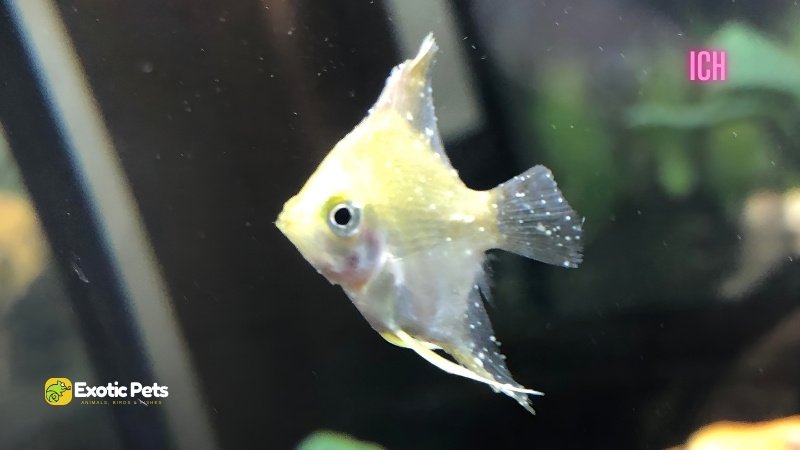
Cause: Protozoan parasite (Ichthyophthirius multifiliis)
Symptoms: White spots on the body and fins, flashing (rubbing against objects).
Treatment: Over-the-counter Ich medications, raising the water temperature to 86°F (30°C) to speed up the parasite’s life cycle, using copper-based medications
Symptoms of Ich in Angelfish
- White Spots: The most obvious sign is the appearance of small, white spots on the fish’s body and fins, resembling grains of salt or sugar.
- Flashing: Infected fish may rub against objects in the tank to try and relieve irritation.
- Increased Mucus Production: You may notice a slimy coating on the fish.
- Labored Breathing: Ich can affect gill function, leading to difficulty breathing.
- Lethargy & Loss of Appetite: Infected fish may become less active and refuse to eat.
Angelfish Ich Treatment
- Quarantine: Isolate the affected fish in a separate tank to prevent the spread of the parasite.
- Raise Temperature: Gradually increase the aquarium temperature to 86°F (30°C) to speed up the parasite’s life cycle and make it more vulnerable to treatment.
- Medication: Consult with a veterinarian or experienced aquarist to choose appropriate anti-parasitic medicines. Common options include those containing malachite green or formalin.
- Remove Carbon: If you have activated carbon in your filter, remove it during treatment, as it can absorb the medication.
- Aquarium Salt: Consider adding aquarium salt (not table salt) to the water. It can help reduce the stress on the fish and make the environment less hospitable to the parasite.
3. Fin Rot in Angelfish
Fin Rot in angelfish is primarily caused by bacterial infections that can opportunistically attack the fins, especially under conditions of poor water quality, stress, or physical injury. The most common bacteria involved include Flavobacterium Columnare, Pseudomonas, and Aeromonas. These bacteria thrive in dirty water and take advantage of weakened fish. Once the fin tissue is damaged, it cannot regenerate, making prevention crucial.
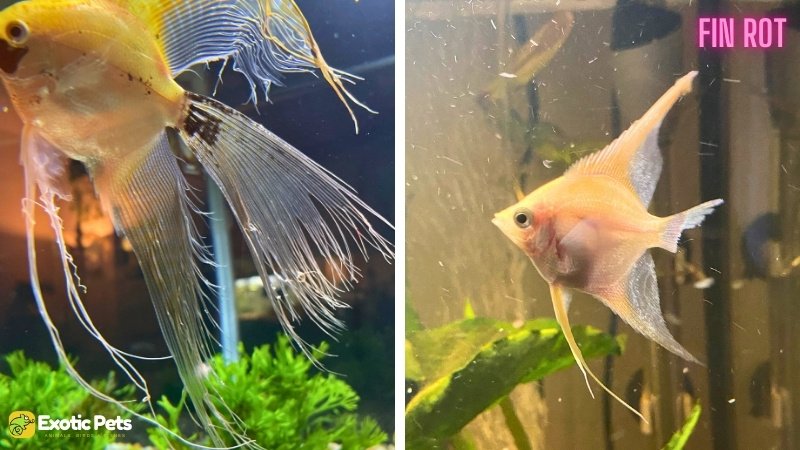
Cause: Bacterial or fungal infection, often due to poor water quality or injuries.
Symptoms: Fins appear ragged, frayed, or discolored.
Treatment: Improve tank cleanliness, antibiotic or antifungal treatment.
Symptoms of Fin Rot in Angelfish
- Frayed Fins: The edges of the fins may appear ragged, torn, or discolored.
- Color Changes: Black or white edges on the fins may develop.
- Missing Tissue: Chunks of fin tissue may be missing.
- Lethargy: The fish may become less active and have difficulty swimming.
- Advanced Stage: In severe cases, the infection can spread to the body, potentially leading to death.
Angelfish Fin Rot Treatment
Effective treatment of Fin Rot involves a combination of improving water conditions and targeted medication:
- Improve Water Quality: Perform frequent partial water changes (50% daily) to remove waste and toxins. Ensure your aquarium filter is functioning properly and test water parameters regularly to maintain optimal conditions.
- Reduce Stress: Minimize factors that could stress your angelfish, such as overcrowding, aggressive tank mates, or sudden changes in water temperature.
- Aquarium Salt: Add aquarium salt (not table salt) to the water at a therapeutic dose. This can help reduce bacterial growth and promote healing.
- Medication: Consult a veterinarian for diagnosis and appropriate treatment. Antibiotics like tetracycline, kanamycin, or nitrofurazone may be prescribed. If a secondary fungal infection is present, antifungal medications may also be necessary.
4. Velvet Disease in Angelfish
Velvet disease, also known as Gold Dust disease, is caused by the dinoflagellate parasites, specifically Piscinoodinium. These parasites attach to fish or contaminated equipment, embedding themselves in the natural slime coating of angelfish and eventually erupting through the skin. Outbreaks typically occur when these parasites multiply more rapidly than the fish’s immune system can handle. This can happen due to stress, poor water quality, or the introduction of infected fish or equipment.
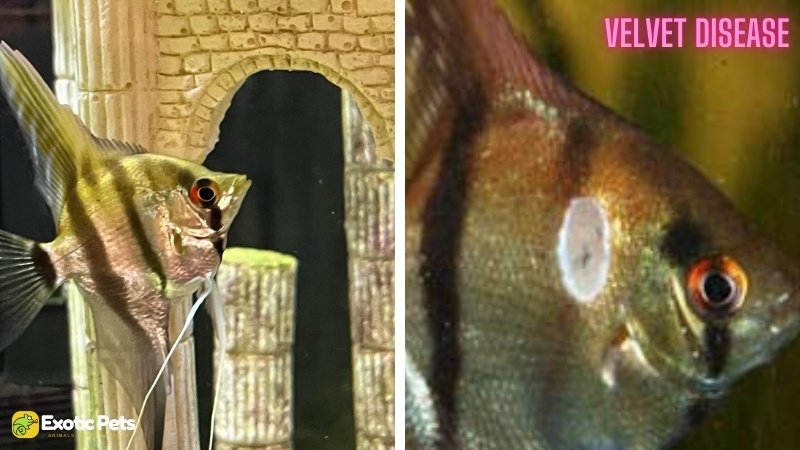
Cause: Parasite (Oodinium).
Symptoms: Gold or rust-colored dust-like coating on the body, clamped fins, difficulty breathing.
Treatment: Copper-based medications, dim aquarium lights, and increased water temperature to 82°F (28°C).
Symptoms of Velvet Disease in Angelfish
- Loss of Color: The fish’s colors may appear dull or faded.
- Yellowish “Dusting”: A fine, yellowish or gold dust-like coating may appear on the skin and fins. This is most visible under bright light or with a flashlight.
- Increased Mucus: The fish may produce excessive slime in an attempt to rid itself of the parasite.
- Flashing: The fish may rub against objects in the tank to try and relieve irritation.
- Labored Breathing: Velvet can affect gill function, leading to difficulty breathing.
- Lethargy & Loss of Appetite: Infected fish may become less active and refuse to eat.
Angelfish Velvet Disease Treatment
- Dim Lights: Reduce aquarium lighting to minimize stress on the fish.
- Raise Temperature: Gradually increase the water temperature to 82-86°F (28-30°C) to speed up the parasite’s life cycle and make it more vulnerable to treatment.
- Medication: Several medications are effective against velvet, including copper-based treatments, formalin, malachite green, and methylene blue. Consult a veterinarian or experienced aquarist for guidance on choosing and dosing the appropriate medication.
- Repeat Treatments: It’s essential to repeat treatments according to the medication instructions, as this will help to kill newly hatched parasites and prevent reinfection.
Important Note: Velvet is highly contagious and can quickly spread throughout an aquarium. Early detection and treatment are crucial. If you suspect your angelfish has velvet, act promptly to protect the rest of your fish.
5. Hexamita (Hole in the Head Disease)
Hexamita, often referred to as Hole in the Head disease, is caused by a parasite called Spironucleus vortens. While the exact cause of outbreaks is still debated, it’s widely believed that poor water quality, inadequate nutrition, and stress weaken the fish’s immune system, making them more susceptible to infection.
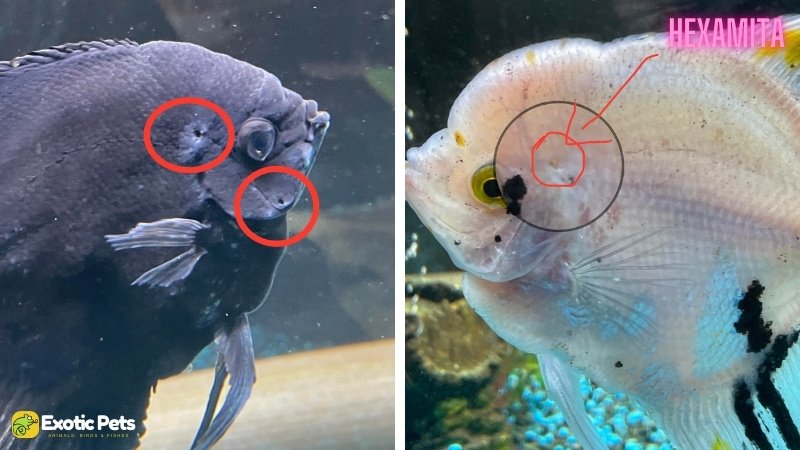
Cause: Parasite (Hexamita).
Symptoms: Lesions or pits on the head and face, loss of appetite, white stringy feces.
Treatment: Metronidazole medication in food or water.
Symptoms of Hexamita in Angelfish
- Indented Holes: The most characteristic sign is the appearance of small, indented holes or pits on the head and face of the fish. These lesions can be shallow or deep and may bleed.
- White Mucus: A white, stringy mucus may be visible near the lesions.
- Erosion: In advanced cases, the erosion may extend to the lateral line and other areas of the body.
- Loss of Appetite: Infected fish often lose their appetite and become lethargic.
- Stunted Growth: Young fish may experience stunted growth due to the parasite’s impact on their health.
- Flashing: Fish may rub against objects in the tank to try and relieve irritation.
Angelfish Hexamita Treatment
- Improve Diet: Provide a varied diet of high-quality live and frozen foods to boost the fish’s immune system.
- Quarantine: Isolate affected fish in a separate tank to prevent the spread of the parasite.
- Water Quality: Maintain excellent water quality through regular partial water changes, proper filtration, and monitoring of water parameters.
- Medication: Consult a veterinarian for diagnosis and appropriate treatment. Medications like metronidazole, nitrofurazone, or tetracycline are often prescribed to combat the parasite.
- Prolonged Treatment: Hexamita can be persistent, so be prepared for a prolonged treatment course to ensure complete eradication of the parasite.
6. Gill Flukes in Angelfish
Gill flukes are tiny parasitic flatworms that attach to and feed on the gills of fish. The most common culprits are Dactylogyrus and Gyrodactylus species. These parasites can be introduced to an aquarium through new fish, live food, or contaminated equipment. Heavy infestations can quickly occur,
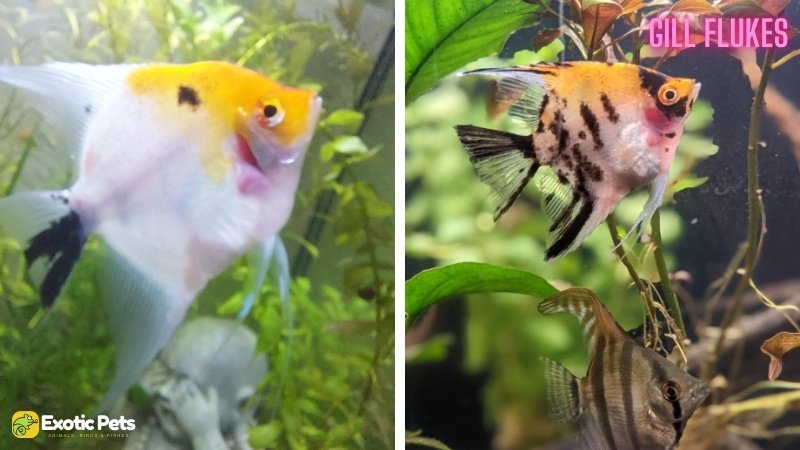
Cause: Parasitic flatworms (Dactylogyrus).
Symptoms: Rapid gill movement, gasping at the surface, lethargy.
Treatment: Praziquantel or formalin-based medications.
Symptoms of Gill Flukes in Angelfish
- Clamped Fins: The fish may hold their fins close to their body.
- Labored Breathing: Infected fish may exhibit rapid, heavy breathing, often gasping at the surface for air.
- Reduced Gill Movement: The gills may appear less active or have a pale color due to damage.
- Flashing: The fish may rub against objects in the tank to try and relieve irritation.
- Mucus Production: White, stringy mucus may be visible hanging from the gills.
- Lethargy: As the infestation worsens, the fish may become lethargic and lose interest in food.
Angelfish Gill Flukes Treatment
- Quarantine: Isolate new fish in a separate tank for observation and treatment before introducing them to your main aquarium.
- Medication: Several medications are effective against gill flukes, including praziquantel, mebendazole, and organophosphates (e.g., trichlorfon). It’s crucial to consult a veterinarian or experienced aquarist for proper diagnosis and treatment recommendations.
- Multiple Treatments: Multiple treatments may be necessary to eradicate the parasites, as some medications only target specific life stages.
- Remove Carbon: If you have activated carbon in your filter, remove it during treatment as it can absorb the medication.
7. Anchor Worms in Angelfish
Anchor worms are parasitic crustaceans (specifically, Lernaea species) that burrow into the flesh of fish. These parasites are highly contagious and can quickly spread through an aquarium if not addressed promptly.
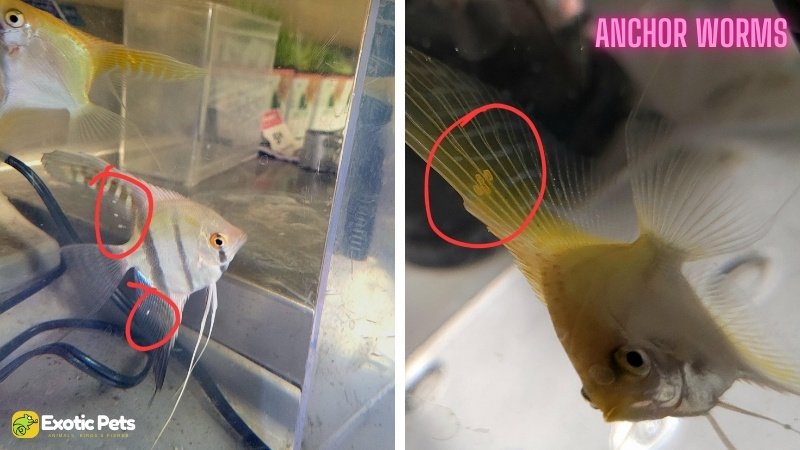
Cause: Parasitic crustaceans (Lernaea).
Symptoms: Visible thread-like worms protruding from the body.
Treatment: Manual removal with tweezers, followed by anti-parasitic medication.
Symptoms of Anchor Worms in Angelfish
- Visible Worms: The most obvious sign is the presence of small, red or brown, thread-like worms protruding from the fish’s body. These worms can grow up to 20mm long.
- Irritation: The worms cause significant irritation, leading the fish to rub against objects in the tank (flashing) in an attempt to dislodge them.
- Open Sores: The attachment sites of the worms often become inflamed and ulcerated.
- Secondary Infections: Open sores can become infected with bacteria, further compromising the fish’s health.
- Loss of Appetite: Infected fish may lose interest in food due to stress and discomfort.
Angelfish Anchor Worms Treatment
- Manual Removal: Carefully remove visible worms with tweezers. Be sure to grasp the worm as close to the base as possible to avoid breaking it off.
- Dim Lights: Reduce aquarium lighting to minimize stress on the fish.
- Medication: Organophosphate medications, like trichlorfon (e.g., Dylox), are effective against anchor worms. Follow the manufacturer’s instructions for dosage and treatment duration.
- Repeat Treatments: It’s essential to repeat treatments as directed, as some medications only kill adult worms. Multiple treatments will be necessary to eliminate newly hatching larvae.
- Water Changes: Perform frequent partial water changes to help remove free-swimming larvae and improve water quality.
8. Swollen Belly (Bloat) in Angelfish
Swollen belly, or bloat, in angelfish is a serious condition with various potential causes, including bacterial infections, internal parasites, constipation, egg impaction, or organ failure.
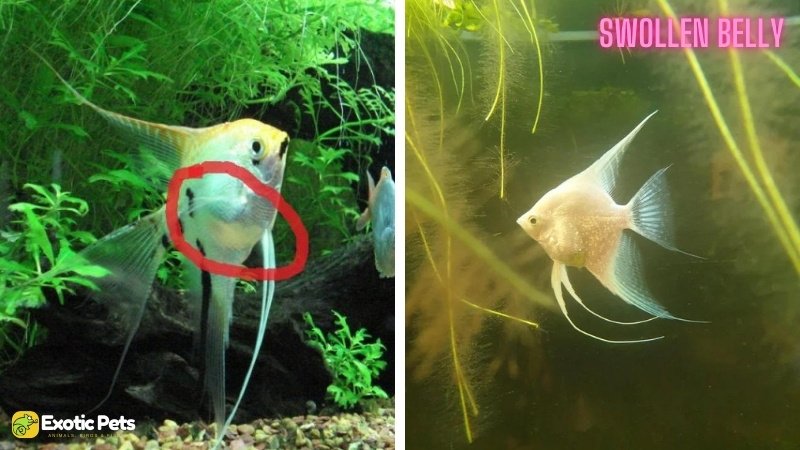
Cause: Overfeeding, constipation, internal parasites, or bacterial infection.
Symptoms: Abnormally swollen abdomen.
Treatment: Depends on the cause. May involve fasting, Epsom salt baths, or medication.
Symptoms of Swollen Belly in Angelfish
- Enlarged Abdomen: The most obvious sign is a noticeably swollen or distended abdomen.
- Loss of Appetite: The fish may lose interest in food.
- Weight Loss: Despite the bloating, the fish may lose weight due to not eating.
- Lethargy: The fish may become less active.
- Raised Scales (Pineconing): In severe cases, the scales may protrude outwards due to fluid buildup.
Angelfish Swollen Belly Treatment
- Identify Underlying Cause: The appropriate treatment depends on the underlying cause of the swollen belly. If you suspect dropsy, hexamita, or other infections, consult a veterinarian for diagnosis and treatment.
- Constipation: For mild constipation, try feeding the fish cooked, de-shelled peas. This can help add fiber to their diet and encourage bowel movements.
- Egg Impaction: In cases of egg impaction, a veterinarian may be able to gently massage the abdomen or administer medication to help the fish release the eggs.
- Organ Failure: If organ failure is suspected, treatment options are limited and prognosis is often poor.
9. Mouth Fungus (Columnaris) in Angelfish
While often called “mouth fungus,” this disease is primarily caused by the bacteria Flavobacterium columnare (also known as Flexibacter columnaris). This bacterium thrives in poor water conditions and attacks fish that are stressed, injured, or already weakened by other health issues.
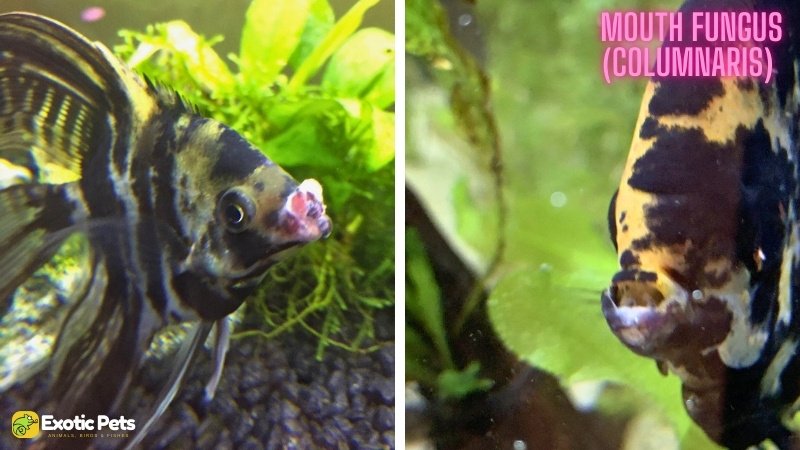
Cause: Bacteria (Flavobacterium columnare).
Symptoms: Whitish or grayish fuzz around the mouth and gills.
Treatment: Antibacterial medications (often containing kanamycin or nitrofurazone).
Symptoms of Mouth Fungus in Angelfish
- White Cottony Growth: The most characteristic sign is a white, cotton-like growth around the mouth, which can spread to the gills and other areas of the body.
- Eroded Tissue: The infection can cause tissue damage, leading to ulcers or lesions around the mouth and face.
- Redness: The affected areas may appear red and inflamed.
- Difficulty Eating: As the infection progresses, the fish may have trouble eating due to pain and tissue damage.
- Clamped Fins: The fish may hold their fins close to their body.
- Lethargy: Infected fish often become less active and may isolate themselves.
Angelfish Mouth Fungus Treatment
- Antibacterial Medications: Since the primary cause is bacterial, antibiotics are the main treatment. Consult a veterinarian or experienced aquarist for recommendations on appropriate medications, such as those containing kanamycin or nitrofurazone.
- Antifungal Medications: Secondary fungal infections can sometimes occur alongside Columnaris. In such cases, antifungal medications may also be necessary.
- Improve Water Quality: Perform frequent partial water changes to remove waste and toxins, and ensure your filter is functioning properly. Maintain optimal water temperature and parameters for angelfish.
- Treat Injuries/Wounds: If the infection originated from an injury, ensure it’s cleaned and treated with an antiseptic to promote healing.
- Nutrition: Feed a high-quality, varied diet to boost the fish’s immune system.
10. Angelfish Popeye (Exophthalmia)
Popeye, also known as exophthalmia, is not a disease itself but a symptom of an underlying problem. It’s characterized by the bulging or protrusion of one or both eyes. Common causes include:
- Bacterial Infections: Bacteria like Streptococcus or Pseudomonas species can infect the tissues behind the eye, leading to inflammation and fluid buildup.
- Injury: Trauma to the eye or surrounding area can cause swelling.
- Gas Bubble Disease: Supersaturation of gases in the water can lead to gas bubbles forming behind the eye.
- Poor Water Quality: High levels of ammonia or nitrite can irritate the eyes and contribute to infection.
- Tumors: In rare cases, tumors behind the eye can cause it to bulge.

Cause: Injury, bacterial infection, or poor water quality.
Symptoms: Bulging eyes.
Treatment: Addressing the underlying cause, antibiotics, or Epsom salt baths.
Symptoms of Popeye in Angelfish
- Protruding Eyes: One or both eyes will visibly protrude from their sockets.
- Redness: The area around the affected eye may be red and inflamed.
- Cloudy Eyes: The cornea may become cloudy or opaque.
- Impaired Vision: The fish may have difficulty seeing, swimming, and finding food.
- Lethargy: Infected fish often become less active.
- Other Signs of Illness: Depending on the underlying cause, the fish may exhibit other symptoms like raised scales, fin rot, or loss of appetite.
Angelfish Popeye Treatment
- Identify the Cause: The first step is to determine the underlying cause of the popeye. A veterinarian specializing in fish medicine can help diagnose the problem.
- Treat Underlying Infection: If a bacterial infection is the cause, antibiotics like kanamycin or tetracycline are often effective.
- Address Water Quality Issues: If poor water quality is a factor, perform frequent partial water changes and ensure proper filtration to maintain optimal conditions.
- Surgery: In severe cases, if the eye is badly damaged or infected, surgical removal may be necessary.
11. Angelfish Cotton Wool Disease (Saprolegniasis)
Cotton wool disease, also known as Saprolegniasis, is a fungal infection caused by Saprolegnia species. These fungi are opportunistic, meaning they typically infect fish that are already weakened by stress, injury, or poor water quality. Secondary bacterial infections often occur alongside the fungal growth, further complicating the issue.
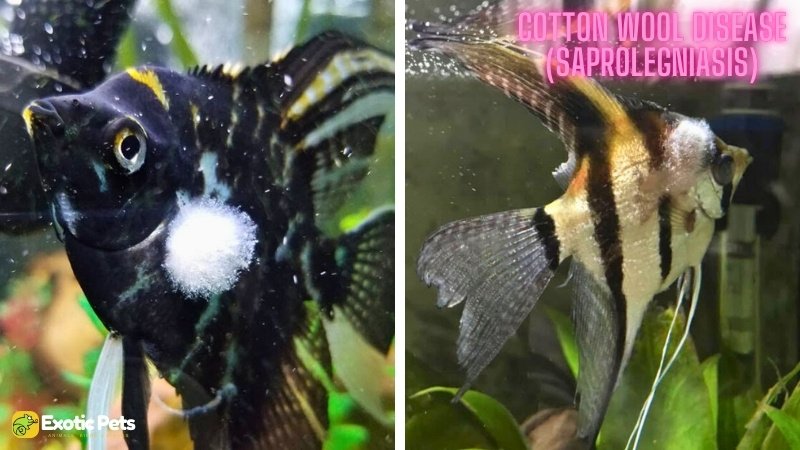
Cause: Fungus (Saprolegnia).
Symptoms: Cotton-like growths on the body, fins, or mouth.
Treatment: Antifungal medications (often containing malachite green or methylene blue).
Symptoms of Cotton Wool Disease in Angelfish
- White Cottony Growth: The most characteristic sign is the appearance of fluffy, white or grayish growths that resemble cotton wool. These growths can appear on the body, fins, mouth, or gills.
- Frayed Fins: The fins may become damaged and ragged due to the fungal infection.
- Red Ulcers: The fungal growth can lead to ulcerations on the body, appearing as red, inflamed sores.
- Lethargy & Loss of Appetite: Infected fish often become less active and lose interest in food.
- Darkening of Skin: The skin may become darker or discolored in the affected areas.
Angelfish Cotton Wool Disease Treatment
- Medication: A combination of antifungal and antibacterial medications is usually necessary. Consult a veterinarian or experienced aquarist for recommendations on appropriate medications, such as those containing malachite green or methylene blue (antifungal) and antibiotics for secondary bacterial infections.
- Remove Necrotic Tissue: If possible, gently remove any dead or decaying tissue using clean tools to promote healing.
- Improve Water Quality: Perform frequent partial water changes to remove fungal spores and improve water conditions.
- Increase Temperature & Add Salt: Slightly raising the aquarium temperature and adding aquarium salt can help inhibit fungal growth and reduce stress on the fish.
- Reduce Stress: Minimize any stressors in the aquarium, such as overcrowding or aggressive tank mates.
12. Swim Bladder Disorder in Angelfish
Swim bladder disease isn’t a single disease but rather a term used to describe a range of issues affecting the swim bladder, an organ that helps fish maintain buoyancy and balance. These problems can be caused by various factors, including:
- Bacterial Infections: Infections in the swim bladder can disrupt its function.
- Physical Injury: Trauma to the swim bladder or surrounding organs can affect buoyancy.
- Constipation: A buildup of food or gas in the digestive tract can put pressure on the swim bladder.
- Tumors or Cysts: Growth on or around the swim bladder can interfere with its operation.
- Parasites: Certain parasites can infect the swim bladder.
- Poor Water Quality: High nitrate levels or rapid temperature fluctuations can stress the fish and impact swim bladder function.
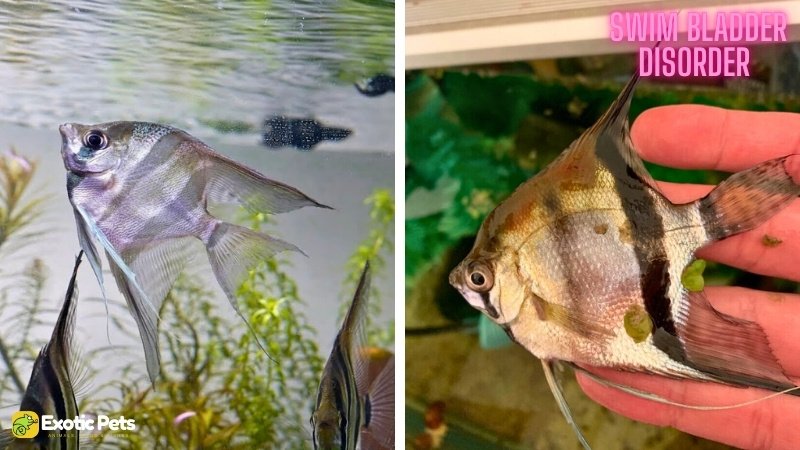
Cause: Infection, injury, constipation, or poor water quality.
Symptoms: Difficulty swimming, floating upside down, or sinking to the bottom.
Treatment: Addressing the underlying cause, fasting, Epsom salt baths, or antibacterial medications.
Symptoms of Swim Bladder Disorder in Angelfish
- Buoyancy Issues: The fish may have difficulty staying upright, swimming erratically, floating upside down, or sinking to the bottom.
- Loss of Balance: They may struggle to maintain their balance and coordination.
- Difficulty Swimming: The fish may have difficulty swimming normally and may appear to be struggling.
Angelfish Swim Bladder Disorder Treatment
- Fasting: If constipation is suspected, withhold food for 24-48 hours, then offer easily digestible food like cooked and shelled peas.
- Antibiotics: If a bacterial infection is suspected, a veterinarian may prescribe antibiotics.
- Adjust Water Temperature: Gradually increase the water temperature to help digestion and reduce inflammation.
- Water Changes: Regular partial water changes can help maintain good water quality and reduce stress on the fish.
- Surgery: In severe cases, surgery may be necessary to correct physical deformities or remove tumors impacting the swim bladder. However, this is a last resort and often carries a poor prognosis.
13. Virus Infections in Angelfish
Angelfish can be susceptible to a variety of viral infections, including those from the iridovirus and herpesvirus families. These infections are often opportunistic, meaning they primarily affect fish whose immune systems are already weakened due to stress, poor water quality, or other underlying health issues.
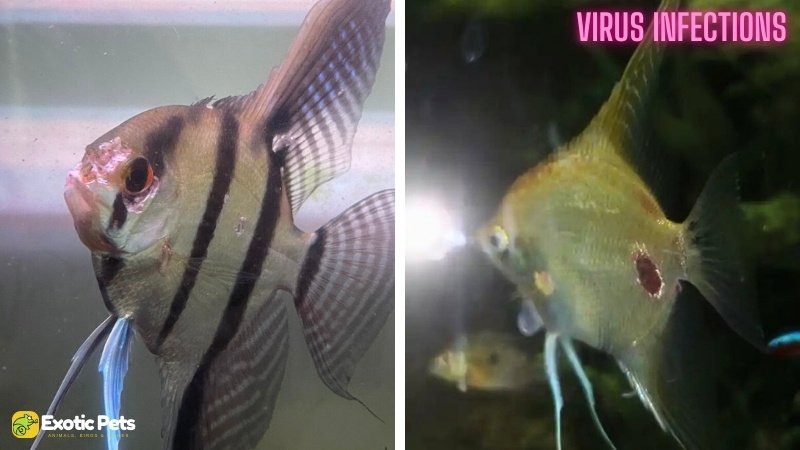
Cause: Various viruses.
Symptoms: Varied, but often include lethargy, loss of appetite, and abnormal swimming behavior.
Treatment: No specific cure for viral infections, focus on supportive care and maintaining good water quality.
Symptoms of Virus Infections in Angelfish
- Ulcers and Sores: Red or white sores may appear on the body and fins.
- Fungal Growth: Secondary fungal infections may develop on the sores or wounds.
- Popeye: One or both eyes may bulge outward.
- Bloating: The abdomen may become swollen (dropsy).
- Neurological Issues: The fish may exhibit abnormal swimming behavior, lethargy, or loss of balance.
- High Mortality: Viral infections can be very serious and often lead to a high mortality rate among affected fish.
Angelfish Virus Infections Treatment
- Quarantine: Immediately isolate any fish showing signs of viral infection to prevent the spread to other fish.
- Supportive Care: Focus on improving water quality, maintaining optimal temperature, and providing a nutritious diet to strengthen the fish’s immune system.
- Treat Secondary Infections: Address any secondary bacterial or fungal infections with appropriate medications as prescribed by a veterinarian.
- No Direct Antiviral Treatment: Unfortunately, there are currently no specific antiviral treatments available for fish.
- Humane Euthanasia: In severe cases where the fish is suffering and recovery is unlikely, humane euthanasia may be the most compassionate option.
Important Note: Viral infections in angelfish are challenging to diagnose and treat. Prevention is key. Maintaining excellent water quality, reducing stress, and quarantining new fish are crucial steps to minimize the risk of viral outbreaks in your aquarium. If you suspect a viral infection, consult a veterinarian specializing in fish medicine for guidance and support.
Monitoring Angelfish Health
Regularly observing your angelfish and their behavior is crucial for early detection of any potential health issues. Pay attention to their appetite, activity levels, and overall appearance. Quarantine new fish before adding them to your main tank to prevent the introduction of diseases.
Conclusion
While this guide covers common angelfish diseases, it’s not a substitute for professional veterinary advice. If you suspect your angelfish is sick, consult a veterinarian specializing in aquatic animals for diagnosis and treatment. With proper care and attention, you can help your angelfish thrive and enjoy a long, healthy life in your aquarium.

